Featured Comment
Just made this, and it turned out so much better-tasting than using the roux cubes. Thank you so much for this recipe!
★★★★★
– gwyn313131 (from Instagram)
Ever stared at that box mix and wished it tasted deeper, less sweet, and more real? This hayashi rice recipe solves that craving in one pan.
Many know famous Western-inspired Japanese dishes like omurice, tonkatsu, hambagu, and even mentaiko pasta, but hayashi rice? It’s the underrated star of yoshoku comfort food.
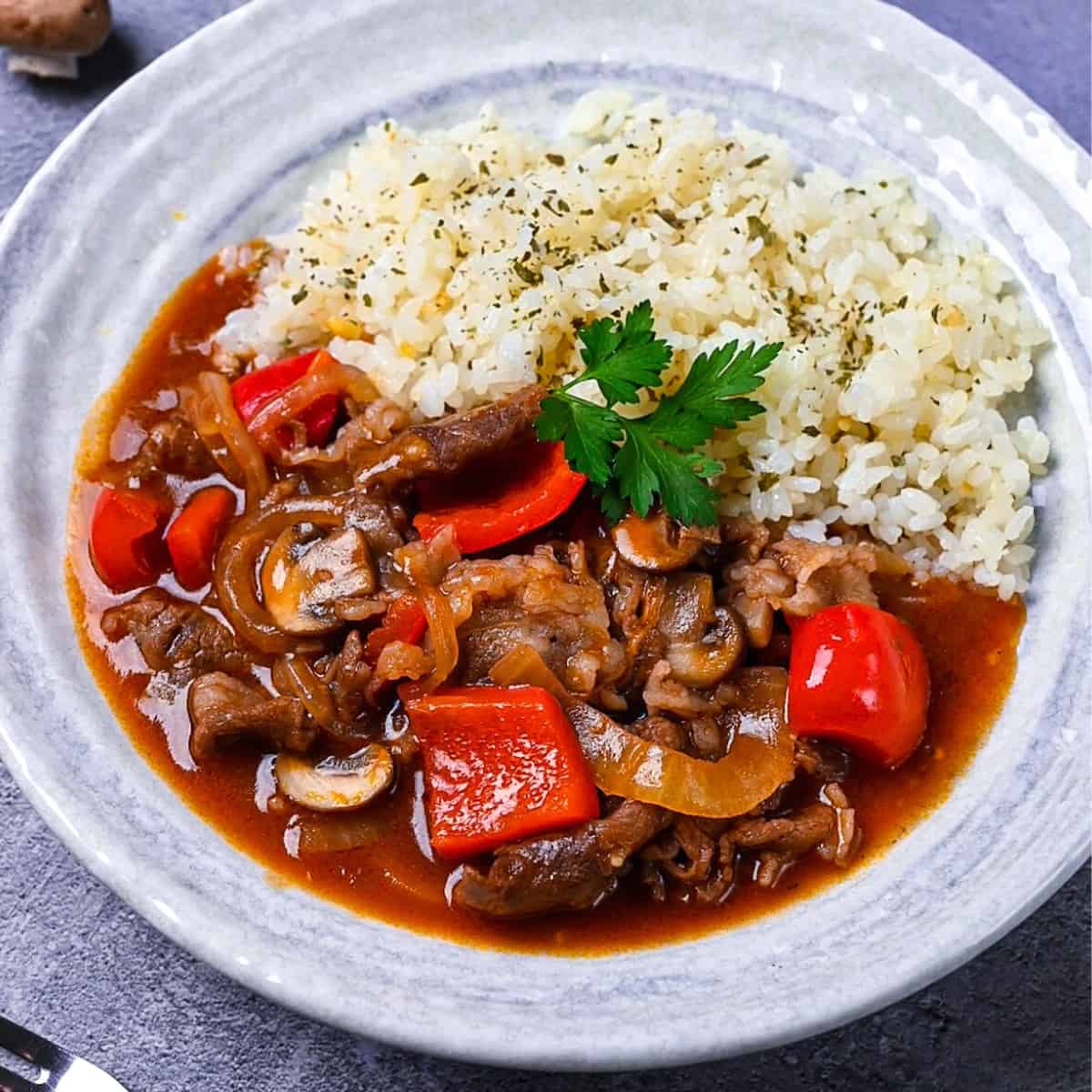
Hayashi Rice
Recipe Snapshot
- What is it? A glossy, wine-simmered beef stew poured over buttered rice.
- Flavor profile: Rich, Savory, Mellow
- Why you’ll love this recipe: It’s impressive enough for dinner guests but forgiving enough for a weeknight. The reliable, crowd-pleasing comfort dish you need in your rotation.
- Must-haves: Sliced beef, Red wine, Heavy-bottomed skillet or shallow Dutch oven
- Skill Level: Easy
- Freezer Friendly? Yes!
- Suitable for Meal Prep? Yes!
Summarize & Save this content on:
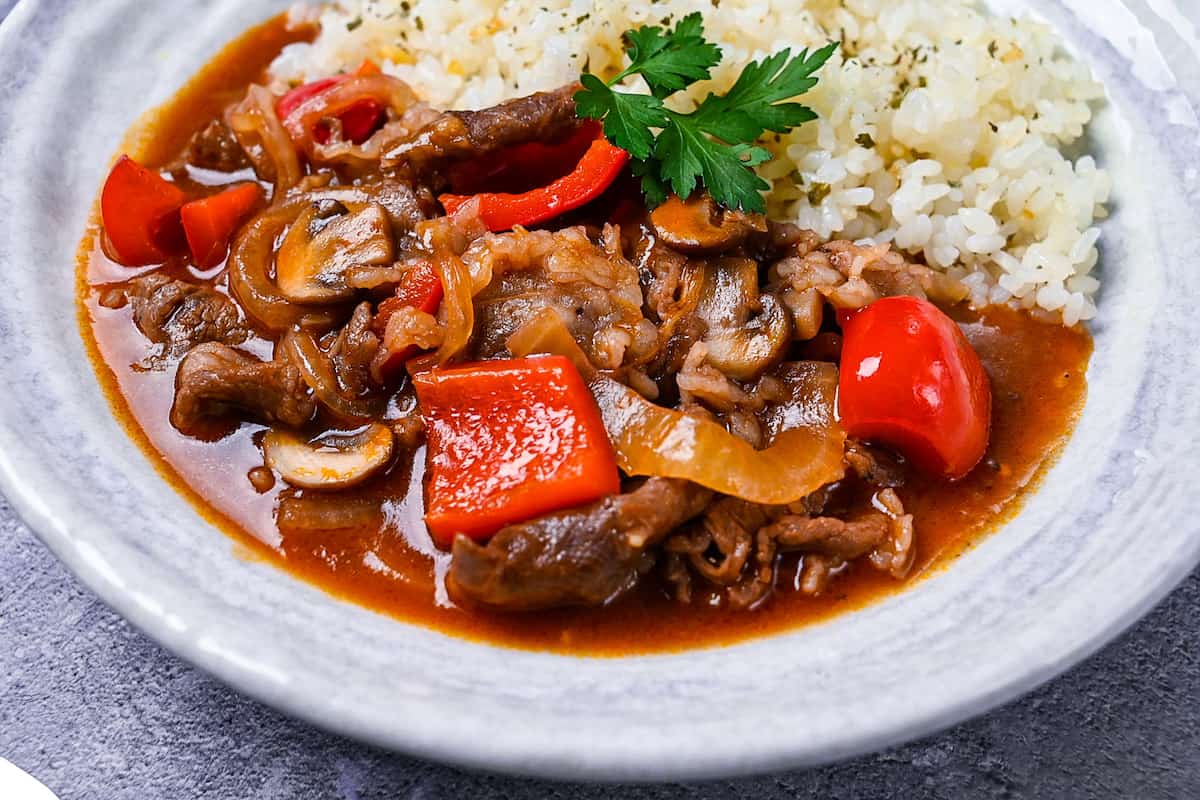
What is Hayashi Rice?
Hayashi Rice (ハヤシライス) is Japan’s take on Western-style comfort food: thinly sliced beef and onions simmered in a glossy, demi-glace-inspired sauce of red wine and tomatoes, then served over fluffy rice. Think of it as the cousin of Japanese curry rice. The look is similar, but the flavor leans more toward rich beef stew.
Like other yōshoku (Western-influenced Japanese cuisine) favorites such as menchi katsu, seafood doria, and crab cream croquette, Hayashi Rice grew out of Japan’s Meiji-era (1868-1912) fascination with European cooking. Over time, it became a beloved “one-plate meal”.
Some say the name “Hayashi” comes from “Hashed Beef with Rice,” others credit a bookseller named Hayashi Yūteki. Either way, the dish became a symbol of modern home cooking.
Hayashi Rice Ingredients
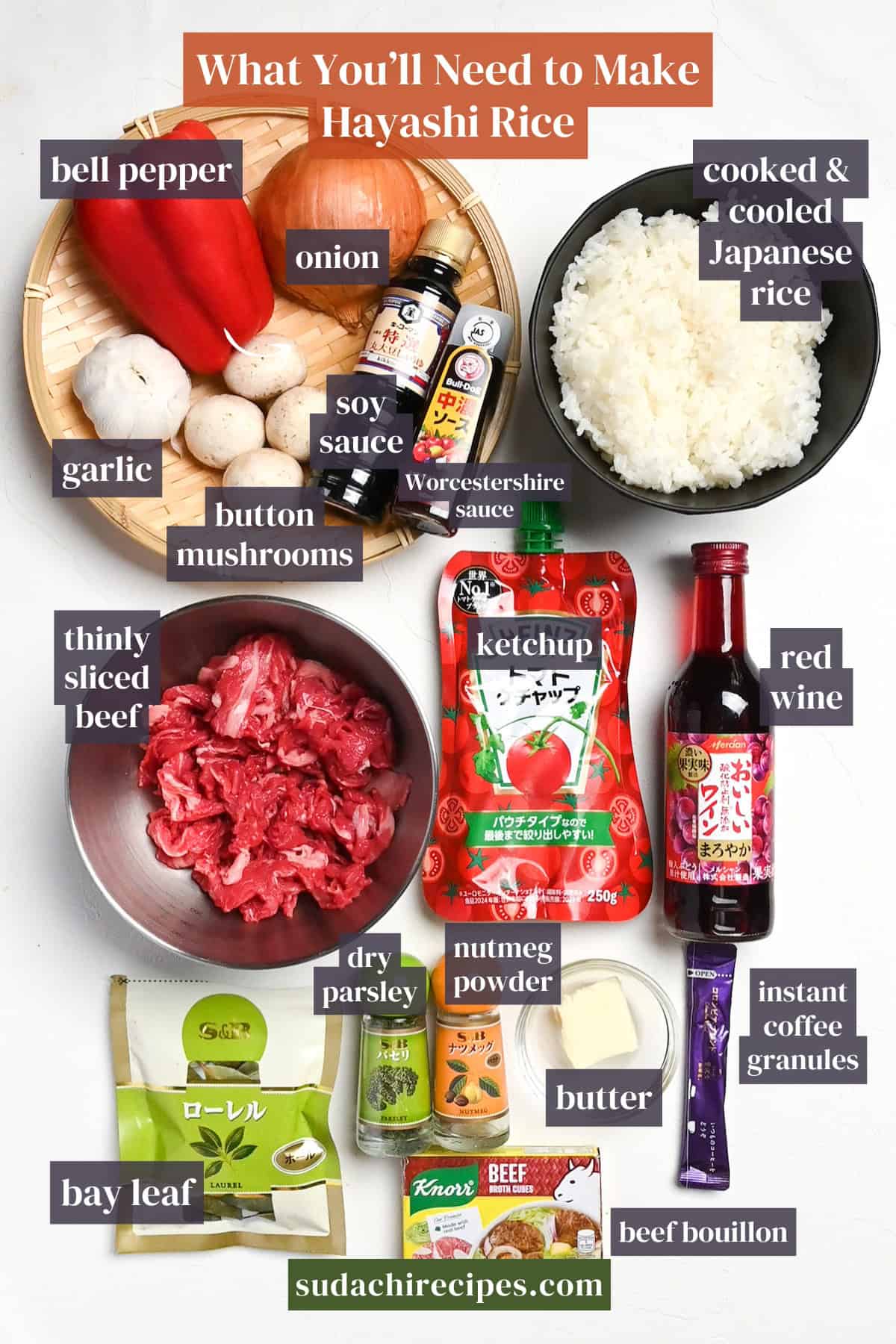
- Beef (thinly sliced; sukiyaki/shabu-shabu or “shaved beef”): You can pick up pre-sliced packs at Asian groceries, and many mainstream stores stock “shaved beef” near the steaks (a butcher can thin-slice chuck or sirloin for you). If you prefer a slightly thicker, silkier finish, that’s also fine.
- Red wine (dry, e.g., Merlot or Cabernet): This brings gentle acidity, a touch of tannin, and dark-fruit warmth. You’ll use it to deglaze so all those browned bits melt into a restaurant-style, jammy sauce. Grab a reasonably priced bottle where you usually shop.
- Mushrooms: They add a cozy, woodsy aroma and a meaty bite that makes the sauce taste deeper. Everyday button/cremini are perfectly fine.
Substitutions
- Beef: Pork shoulder or pork belly sliced thin works too (milder, slightly sweeter).
- Worcestershire Sauce: Lea & Perrins Worcestershire is perfectly fine, but use slightly less since it’s thinner and sharper than Japanese Worcestershire. Other options are HP Sauce or even a touch of A.1. Steak Sauce.
- Beef Stock: Chicken or pork bouillon cubes can work.
Have trouble finding Japanese ingredients? Check out my ultimate guide to Japanese ingredient substitutes!
How to Make My Hayashi Rice
If you prefer to watch the process in action, check out my YouTube video of this hayashi rice recipe!
Before you start: Slice the onion into thin wedges, mince the garlic, slice the mushrooms, and cut the bell pepper into bite-sized irregular pieces.
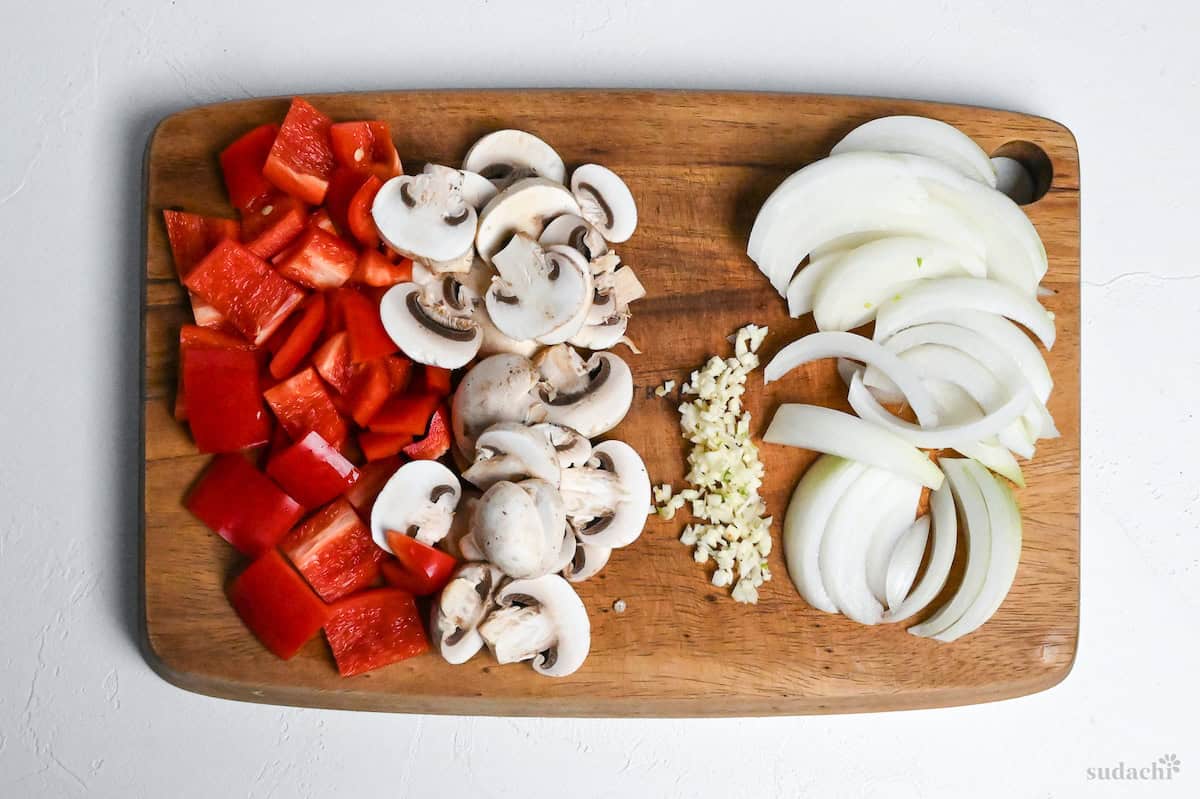
Also, make beef bouillon using your regular cubes (I use Knorr). Make sure to read the package directions carefully. Cube-to-water ratios aren’t standardized. Using the wrong ratio will make your sauce either overly salty or bland and thin. Always follow your specific brand’s ratio.
i. Toss thinly sliced beef with a pinch of salt and all-purpose flour until every piece is lightly coated. The flour speeds browning by drying the surface and later gives the sauce a gentle body. Look for a matte, velvety coat with no white clumps.
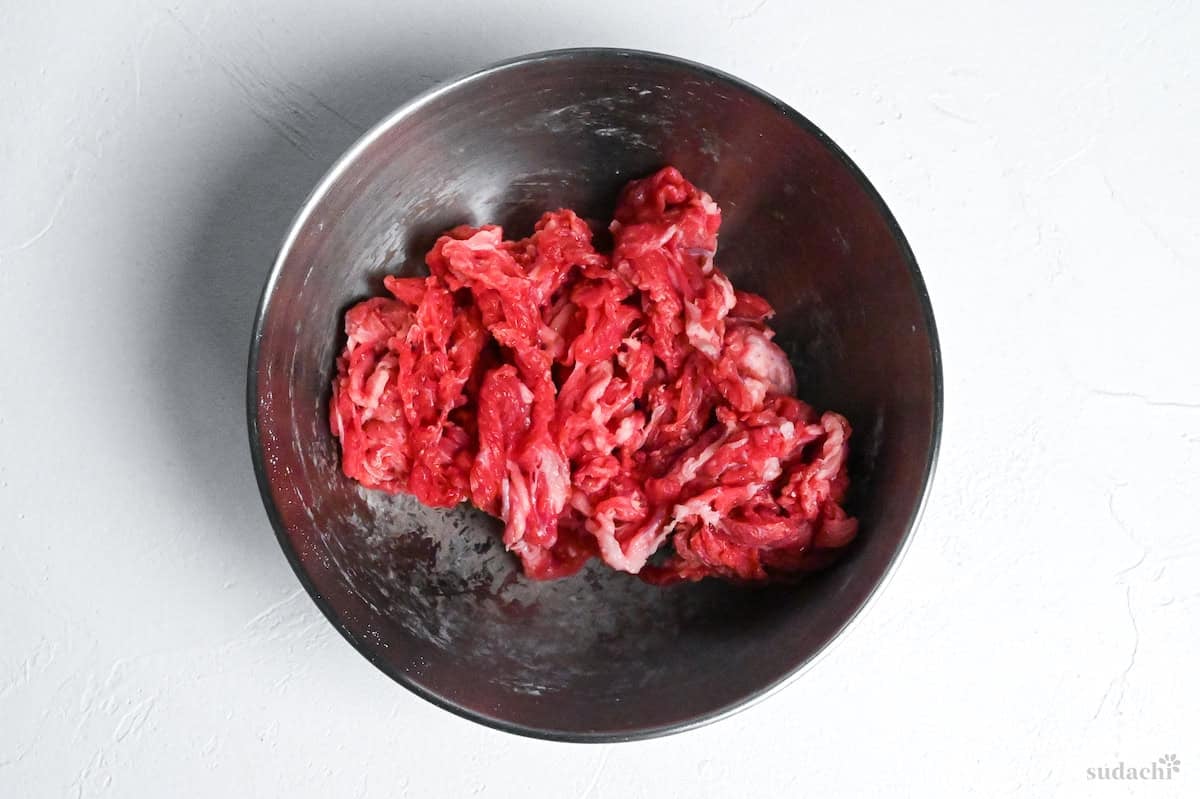
If thinly sliced beef isn’t available, ground beef (around 80/20 lean-to-fat ratio) works surprisingly well as a substitute.
ii. Set a large pan over medium to medium-low heat and add a thin film of neutral oil and wait until it shimmers. A properly preheated pan minimizes sticking and preserves the fond (the browned bits you’ll turn into sauce).
iii. Add the beef and mushrooms in a loose, single layer and sear until the undersides are well browned, then flip once and brown the second side.
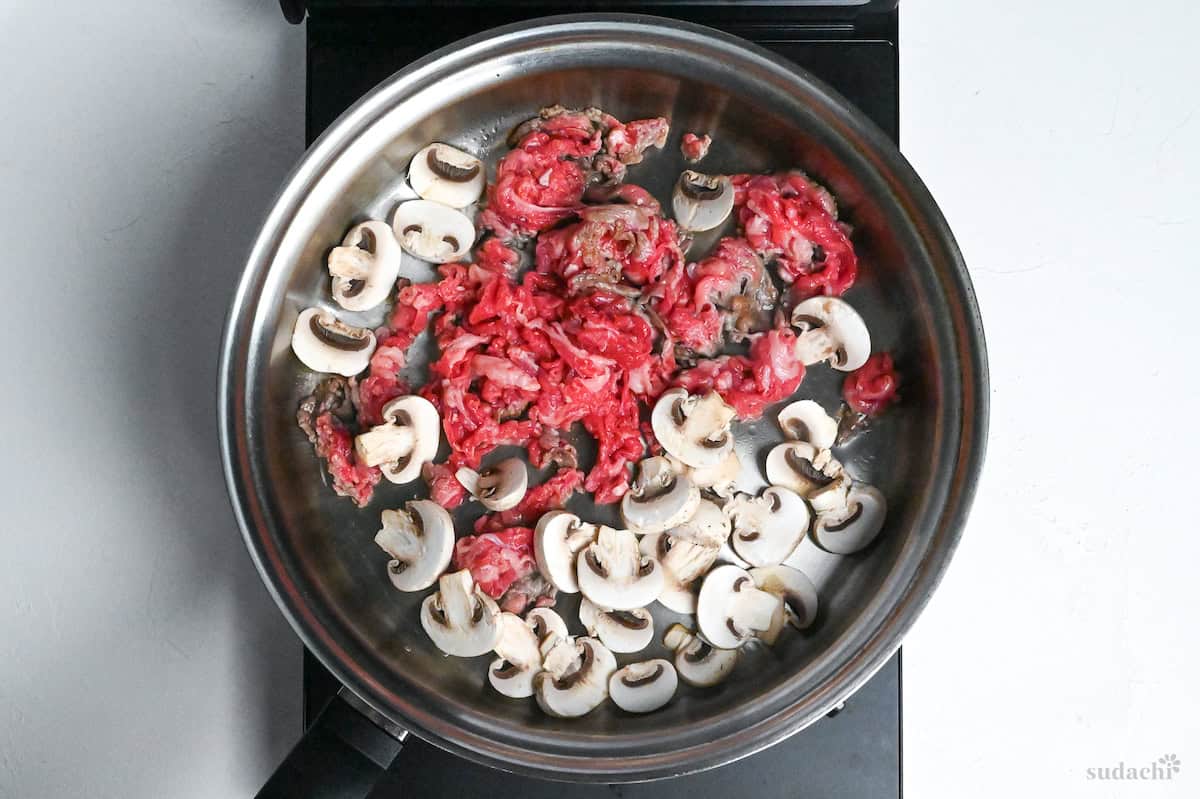
iv. Pull them out when the surfaces are browned.
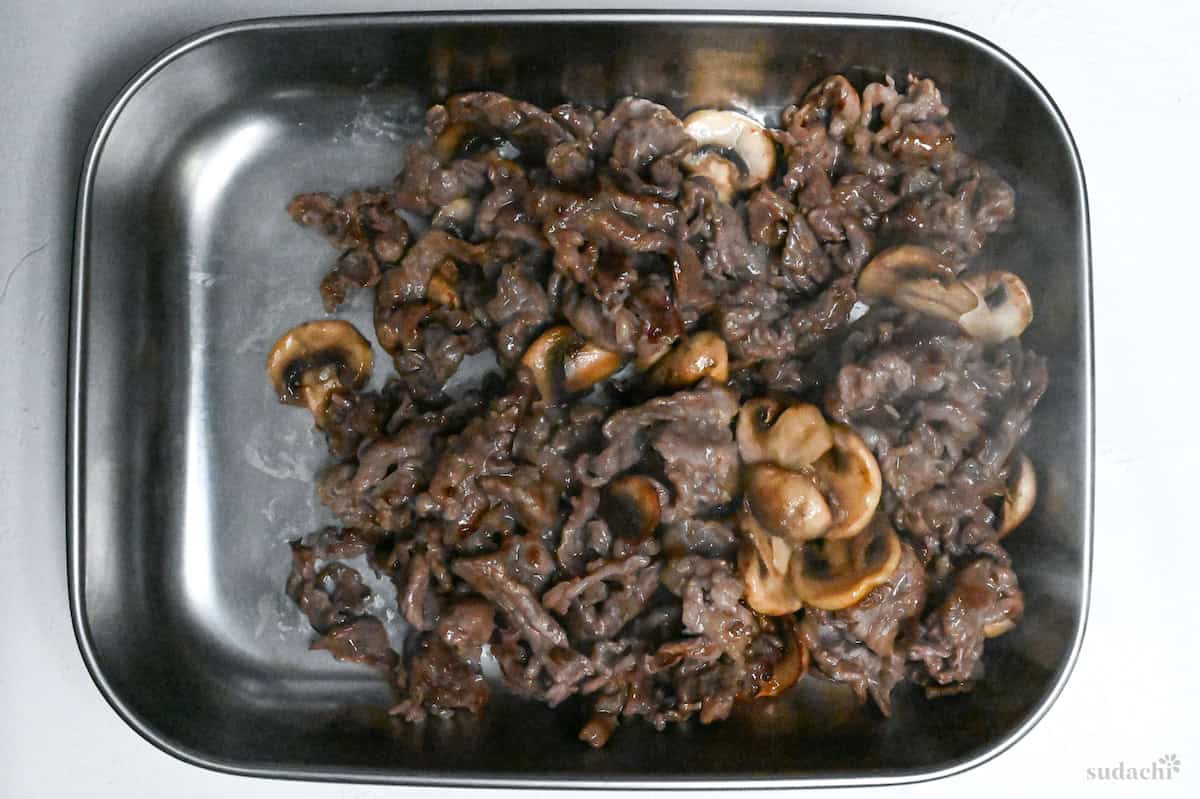
i. Add the thinly sliced onion with salt and cook, scraping occasionally, until the onions turn golden and sweet. If onions threaten to scorch, splash in a spoonful of water, scrape, and keep going.
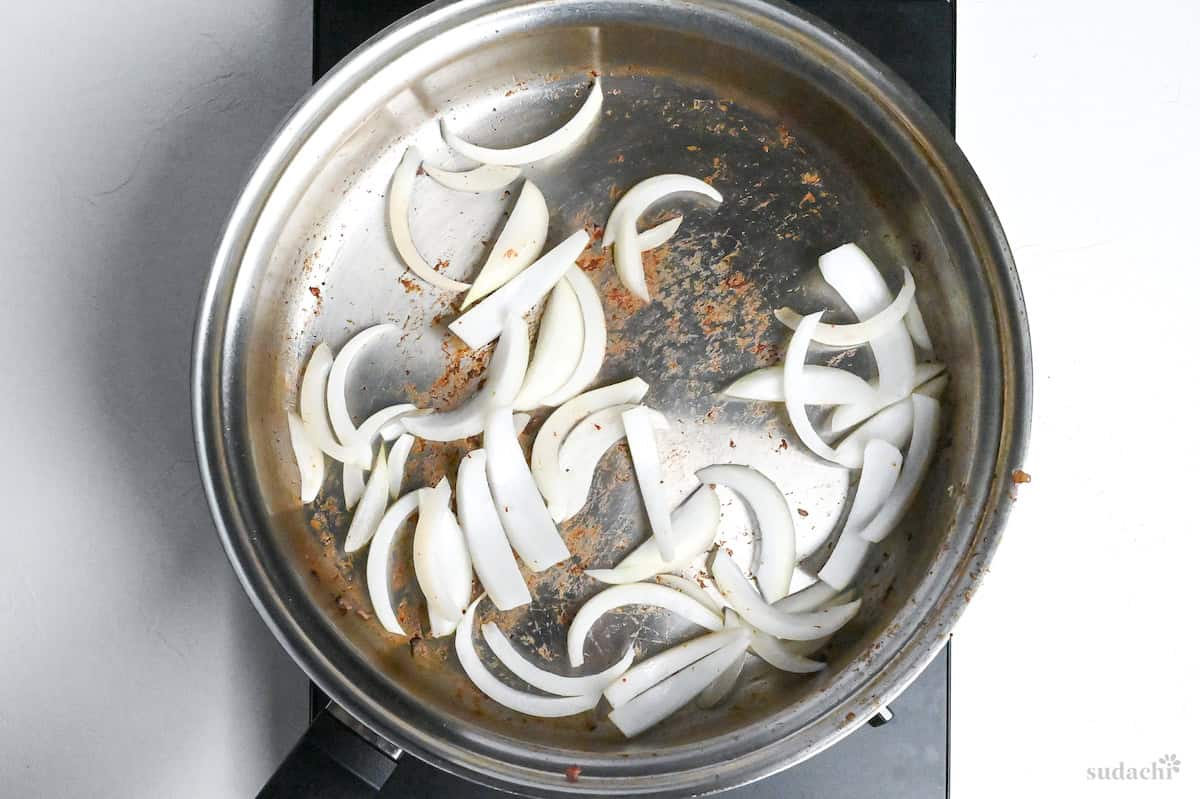
Well-browned onions intensify color toward a chocolate-tinted reddish brown and supply nutty, savory notes that define hayashi sauce.
i. Stir in minced garlic and bell pepper, for about 30 seconds until fragrant.
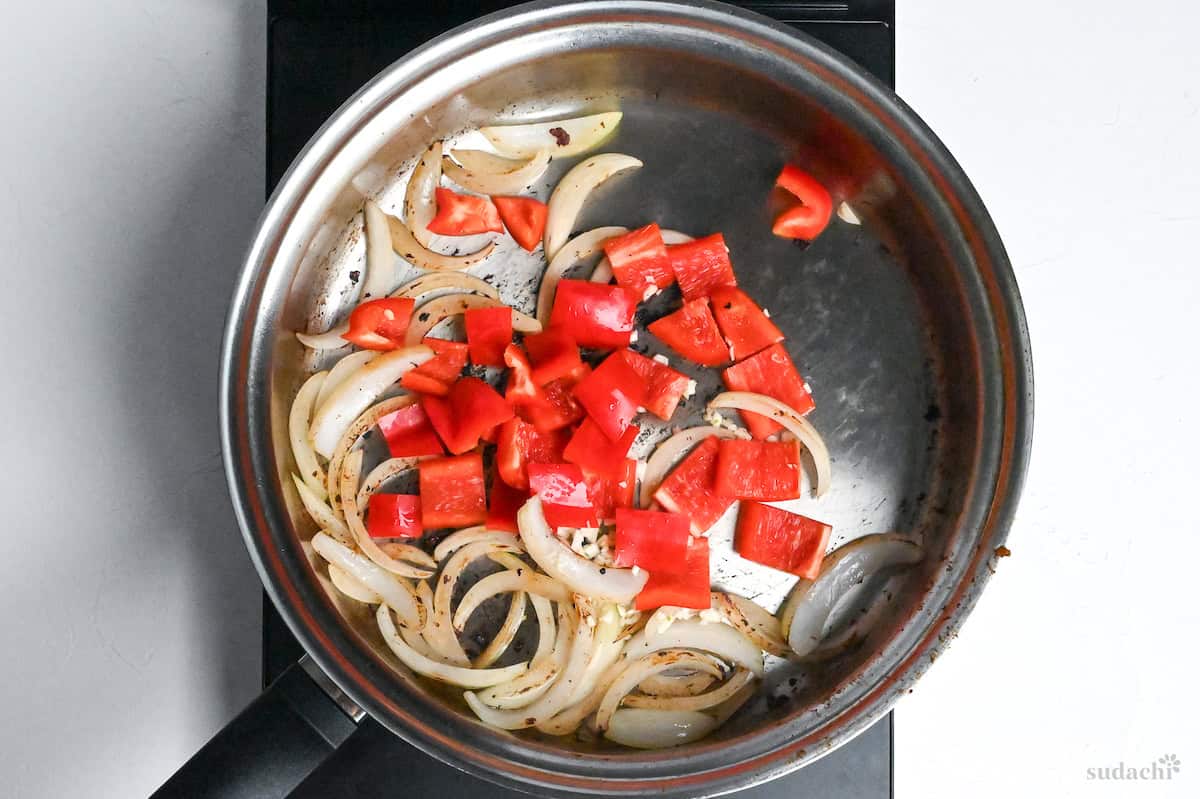
ii. Pour in red wine, raise the heat, and scrape up every browned bit as the wine bubbles. Cook until the sharp alcohol aroma fades and the pan looks nearly syrupy. This transfers the fond into your sauce base and concentrates flavor.
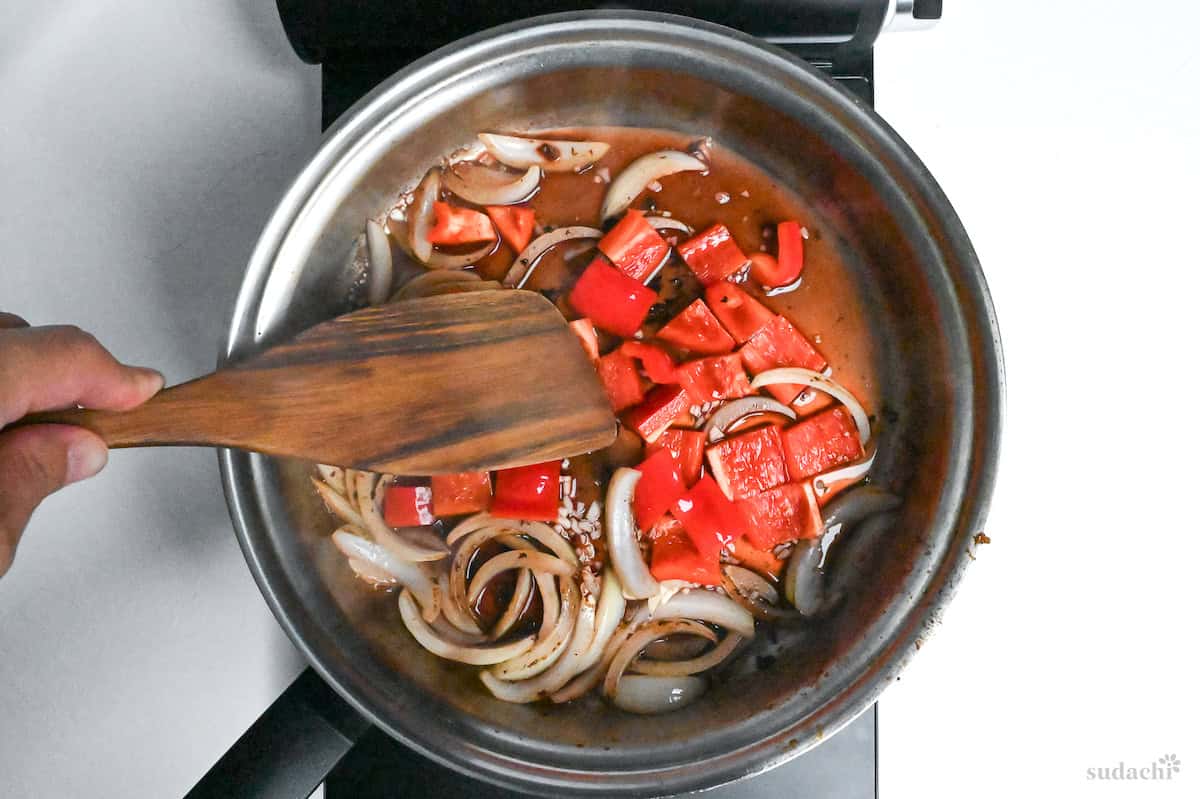
Wine dissolves and lifts the browned sucs/fond into the liquid so you don’t leave flavor on the pan. Reducing it “almost dry” before adding stock knocks back alcohol harshness and builds body.
i. Return the beef and mushrooms to the skillet and sprinkle flour over the mixture, tossing for 30-60 seconds. This quick cooking step removes raw flour notes and primes the starch to thicken smoothly later. If anything starts to stick, moderate the heat and keep the mixture moving.
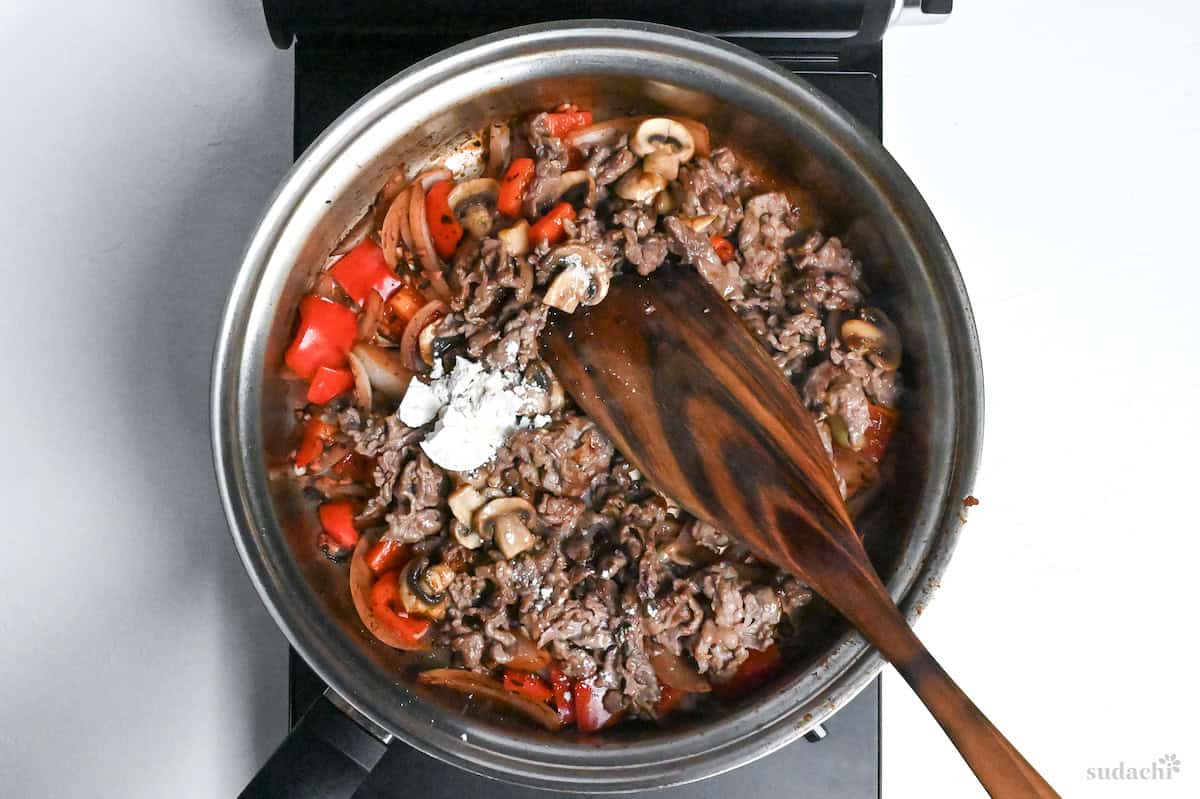
Roux-based sauces need time/heat to lose raw flour taste. Even brief cooking now reduces that flavor before the simmer finishes the job. Think of this as “pre-toasting” the thickener for a silkier finish.
ii. Stir in ketchup, Worcestershire sauce, and soy sauce, cooking about 1 minute until glossy and fragrant.
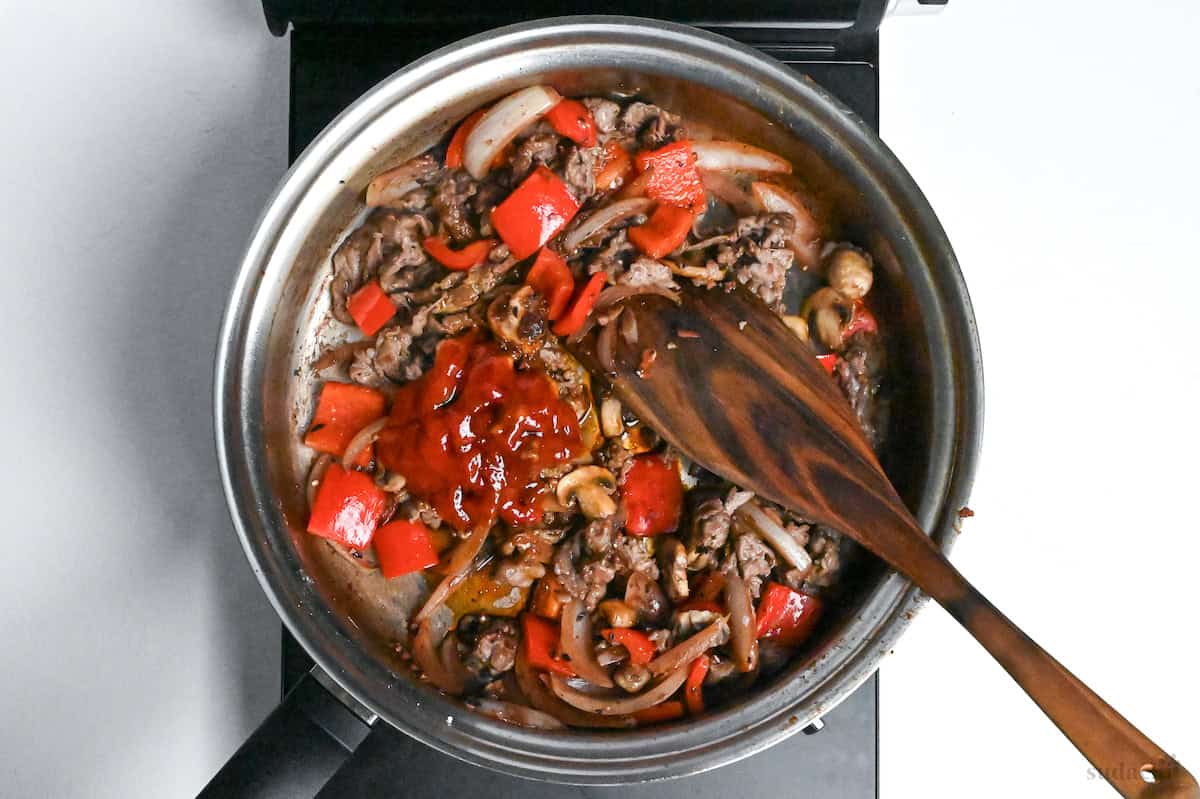
For a cleaner, less sweet flavor, try using tomato paste (less amount) instead of ketchup, and opt for Lea & Perrins Worcestershire sauce.
iii. Brief frying drives off excess water, rounds acidity, and deepens the reddish-brown color. If it smells sharp or tangy, keep stirring until it smells jammy and savory.
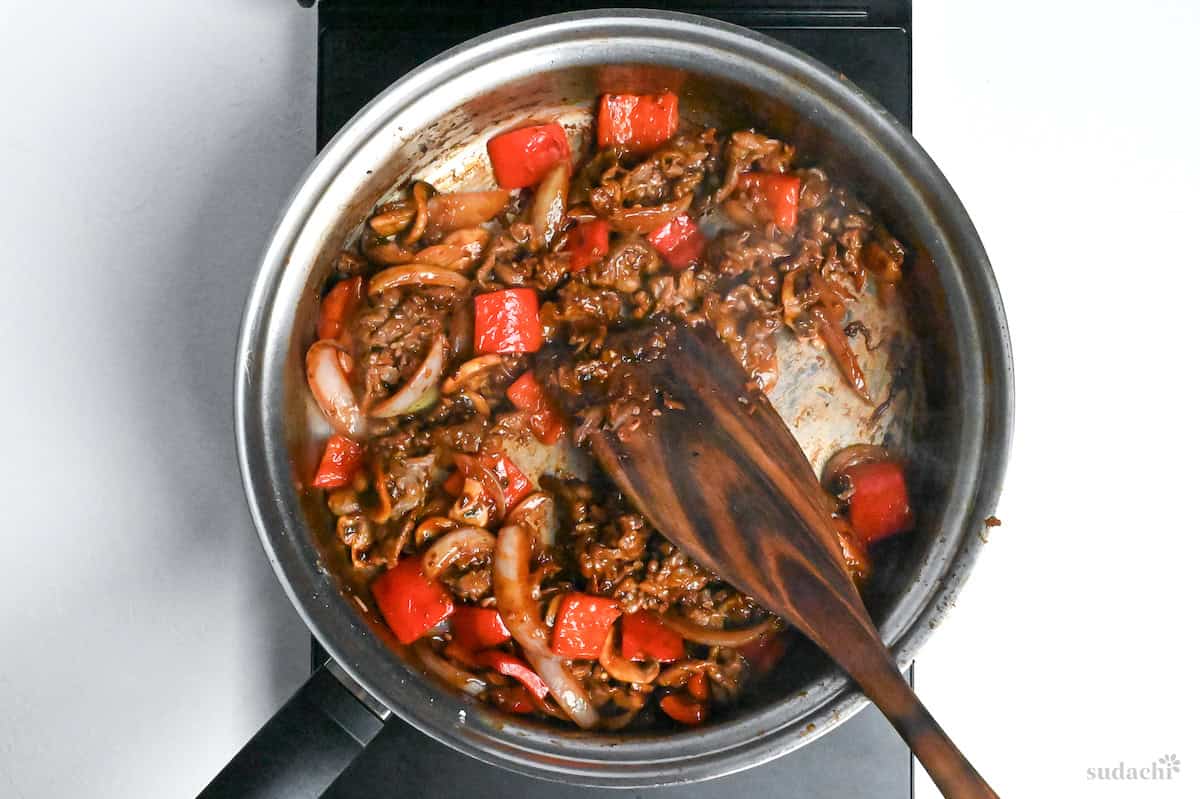
i. Pour in beef bouillon and add bay leaf. Bring to a gentle simmer, about 85-96℃ (185-205°F) and cook 5 minutes, stirring now and then, until the sauce lightly coats the back of a spoon.
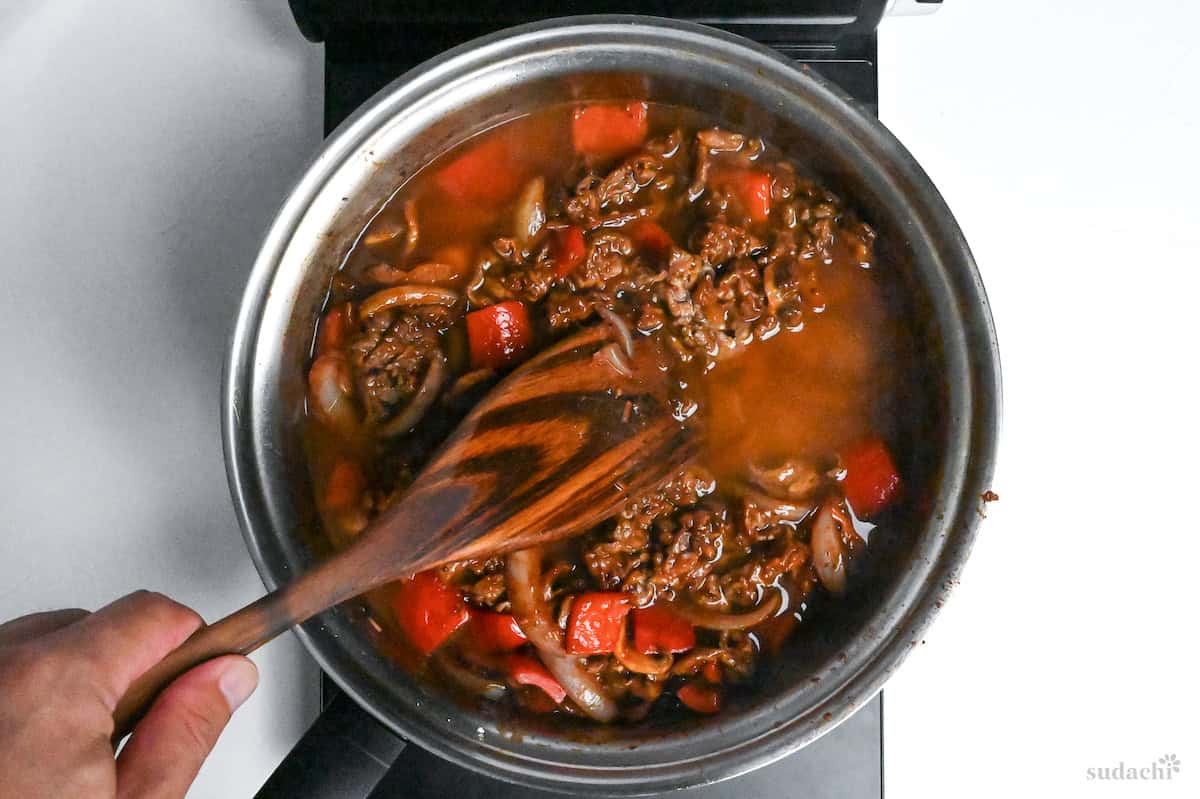
ii. Keep it at a simmer, not a boil, to preserve tenderness and shine.
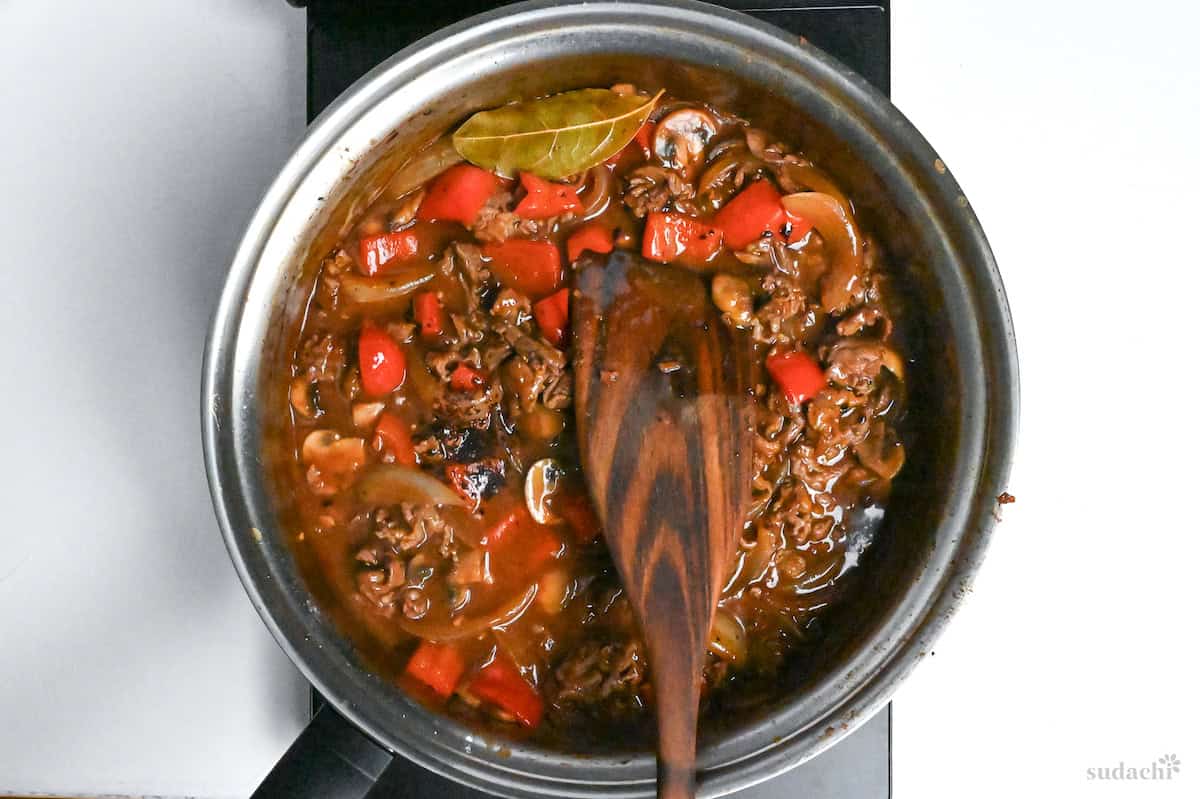
Ideal texture is just looser than curry. It should slowly flow if you tilt the pan and cling to a spoon in a thin film. Too thin? Simmer a bit longer. Too thick or pasty? Loosen with hot stock or water.
iii. You can stir in instant coffee or finely grated dark chocolate, tasting as you go. You’re adding a subtle bitter note for depth (optional).
i. While the sauce is simmering, in a second pan over medium heat, melt butter with minced garlic clove until aromatic.
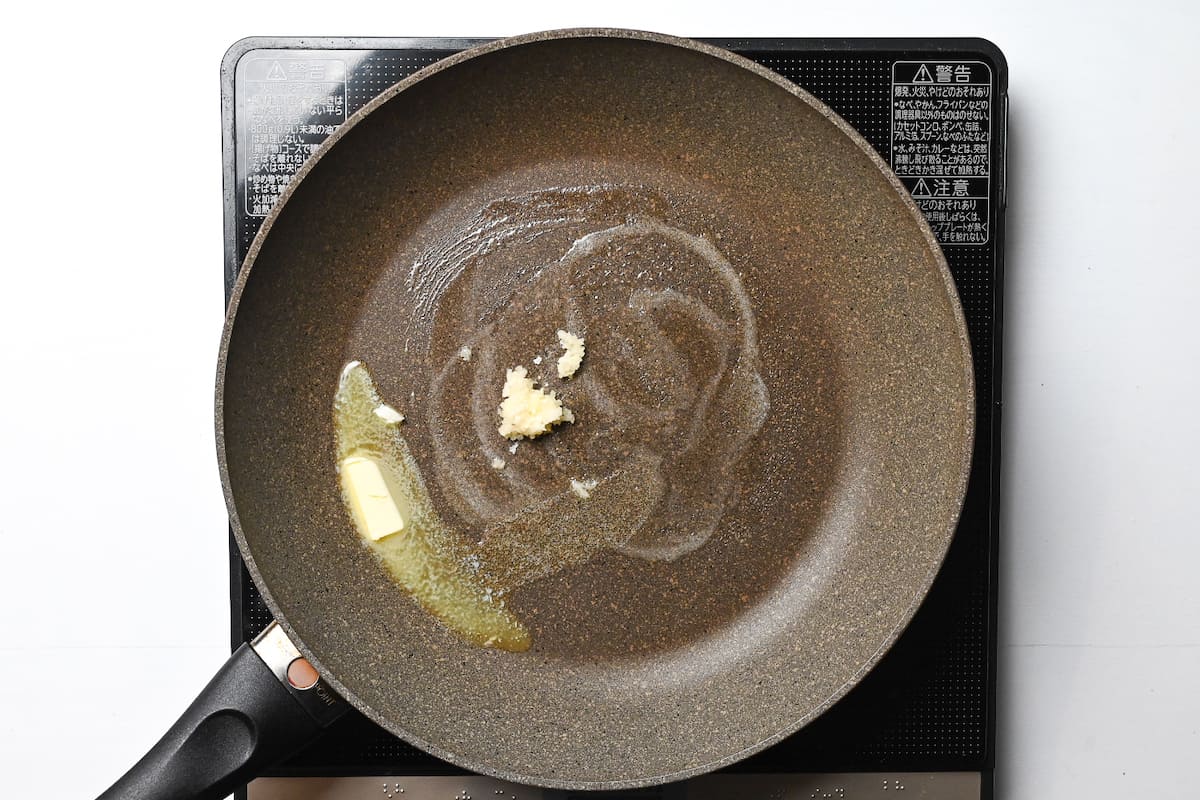
ii. Add cooked Japanese short-grain rice and sauté a few minutes to drive off excess moisture so grains glisten without getting greasy.
Day-old, cold rice separates more cleanly and fries faster. Freshly cooked rice should be cooled uncovered for a few minutes to reduce surface moisture before sautéing.
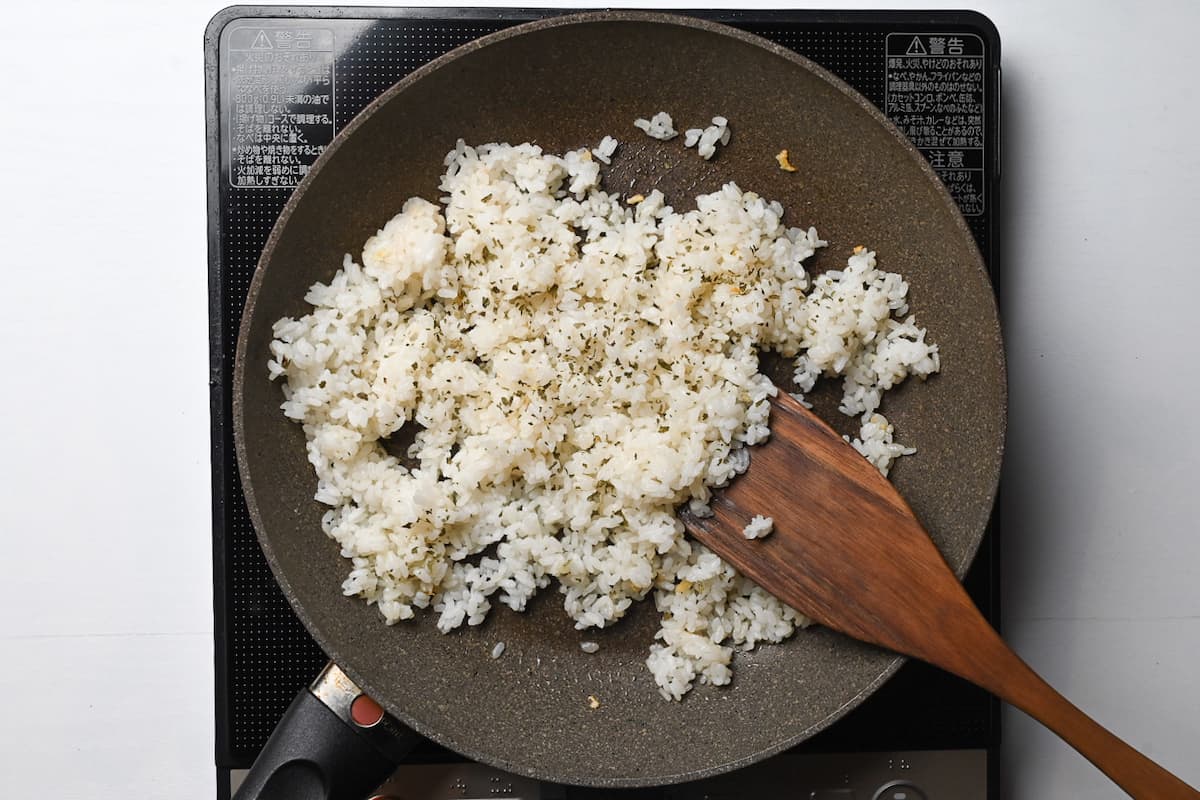
iii. Sprinkle in parsley and fold until evenly green.
i. Turn off the heat under the hayashi, season with freshly ground pepper and a touch of nutmeg, then mount with cold butter, swirling until the sauce turns satiny.

ii. Aim to finish below about 80℃ (176°F) so the emulsion stays stable.
“Monter au beurre” emulsifies butterfat into the watery phase of your sauce, giving gloss and body without heaviness when done off-heat and gradually. That stable emulsion is why the sauce looks shiny but not oily.
i. Mound the rice on one side of a warm plate and ladle the hayashi alongside. Finish with a pinch of parsley for color contrast.
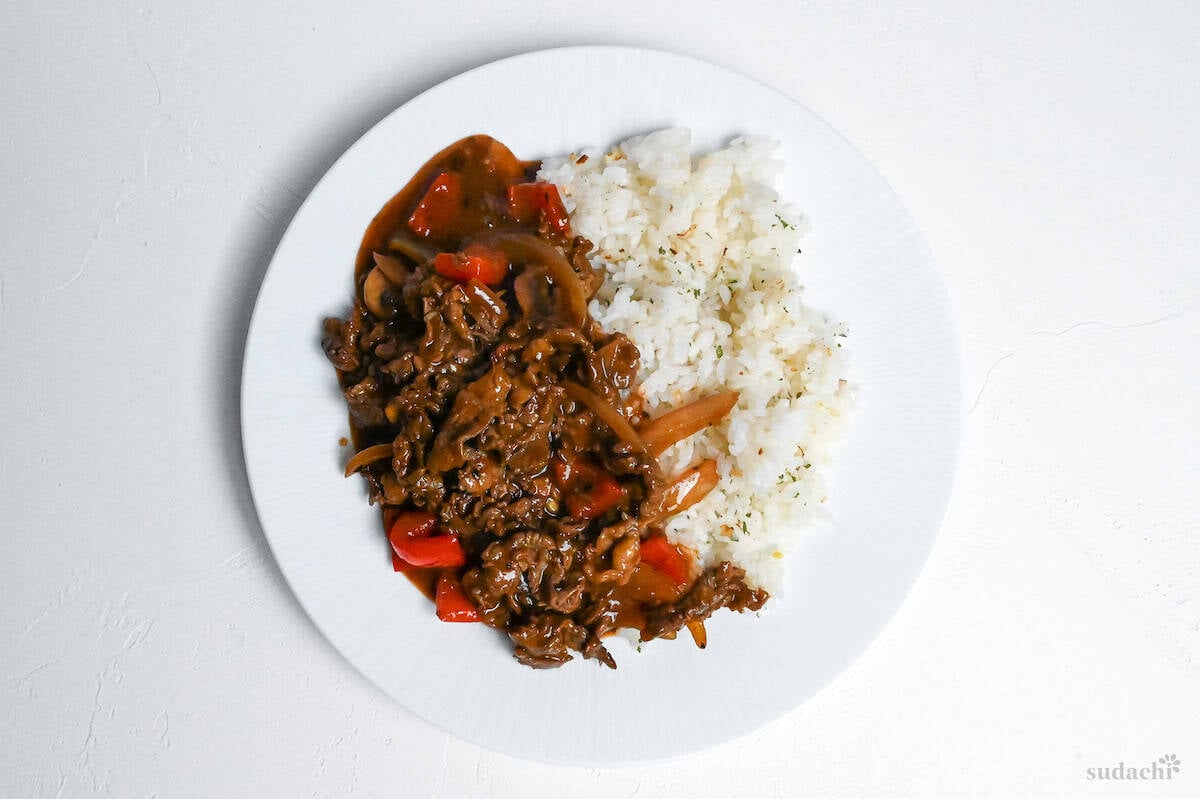

Essential Tips & Tricks
- Golden onions = flavor depth. Keep sautéing until onions reach a amber.
- Deglaze! When you pour in red wine, scrape up every browned bit. This is concentrated flavor that defines hayashi sauce.
- Cook the flour, don’t rush it. Stir the flour into the hot pan for 30-60 seconds before adding liquid to remove raw taste and ensure smooth thickening.
- Simmer, don’t boil. Maintain a gentle bubble at around 90℃ (195°F).
- Butter off-heat for shine. Swirl in butter once the sauce is below 80℃ (175°F) to emulsify instead of separating.
With these simple tips in mind, you’re set for success every time you make hayashi rice.
Storage & Meal Prep
Fridge: Airtight container, about 3 days for hayashi beef + sauce. Cool quickly, then refrigerate. Store rice separately. If you must refrigerate rice, use within 1 day and reheat with a splash of water to soften.
Freezer: Airtight, flat-packed portions, up to 1 month for sauce with beef and mushrooms. Freeze rice in separate single-serve packets up to 1 month.
Meal Prep: Chop onions/pepper and slice mushrooms 24 hours ahead (refrigerated). Season beef with salt in advance but dust with flour right before cooking to avoid pasty surfaces. For full prep, cook the sauce, cool fast, portion with separately cooked rice (or leave rice out), and label with date. Plan add-ins (butter, cream, coffee/chocolate) at reheat for freshest flavor.
Reheating: Stovetop: Bring chilled or thawed portions to a gentle simmer, add a splash of water if too thick or reduced. Microwave: Vent-covered container, stir midway, heat until bubbling throughout. From frozen: Thaw overnight in the fridge. Do not refreeze once thawed.
What to Serve With This Recipe
Hayashi Rice Q&A
Overcooking thin slices. Next time, sear quickly, remove, and finish briefly in the sauce. Light flouring helps retain moisture and gentle heat prevents tightening.
Reduce acidity by simmering ketchup and wine long enough, or balance finished sauce with a small amount of sugar. Dairy (milk/cream/butter) can mellow sharpness too.
The exact origin is unclear, but 3 main theories exist. One credits a chef named Hayashi at Tokyo’s Seiyōken restaurant in the Meiji era, who created a staff meal of leftover beef and vegetables simmered in demi-glace over rice. Another links it to Maruzen founder Eikichi Hayashi, either from a beef stew he served to patients when he was a doctor or a Western-style dish he later ordered for colleagues, both stories recorded in Maruzen’s archives. A third theory traces the name to “Hashed Beef with Rice,” an old English dish whose shortened form “Haishi Rice” evolved into “Hayashi Rice.”
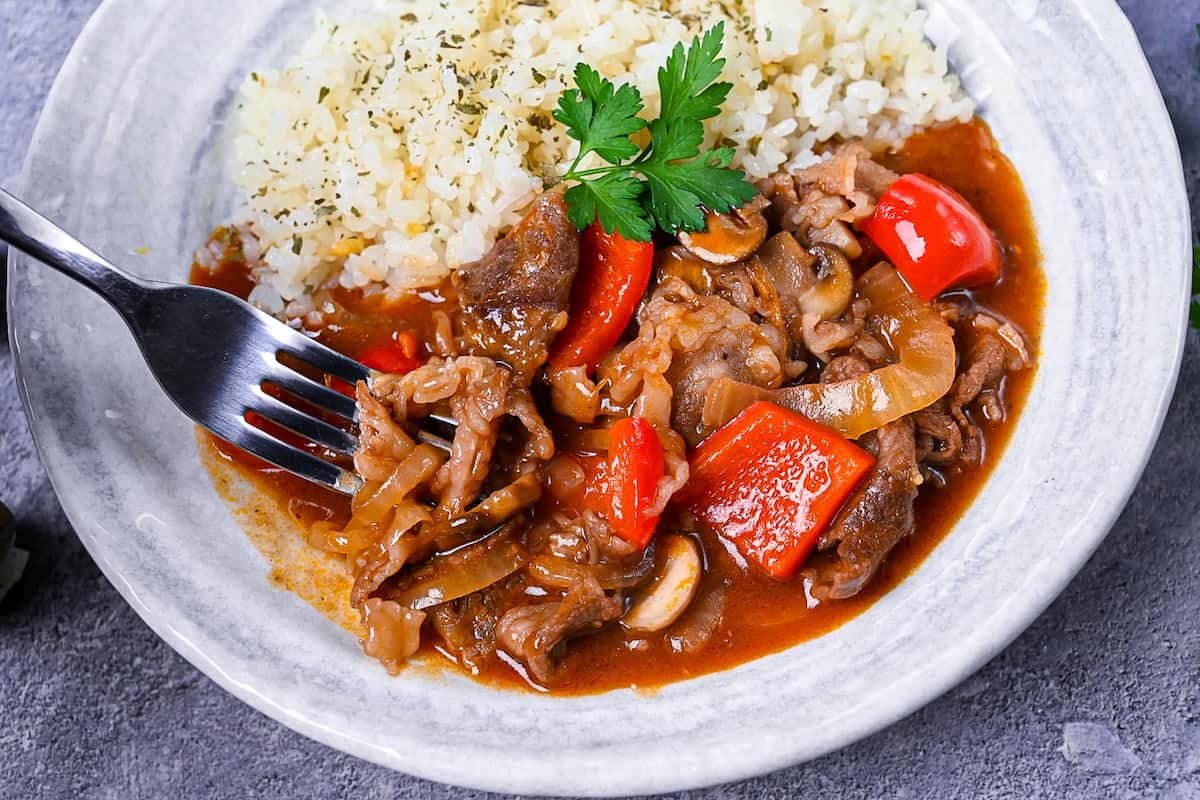
More Japanese Dinner Recipes
- Authentic Teriyaki Chicken
- Hambagu (Japanese Hamburger Steak)
- Japanese Style Mapo Tofu
- Miso Marinated Beef Steak
Looking for what to cook tonight? Browse through my curated collection of Japanese dinner ideas!
Did You Try This Recipe?
I would love to hear your thoughts!
💬 Leave a review and ⭐️ rating in the comments below. 📷 I also love to see your photos – submit them here!
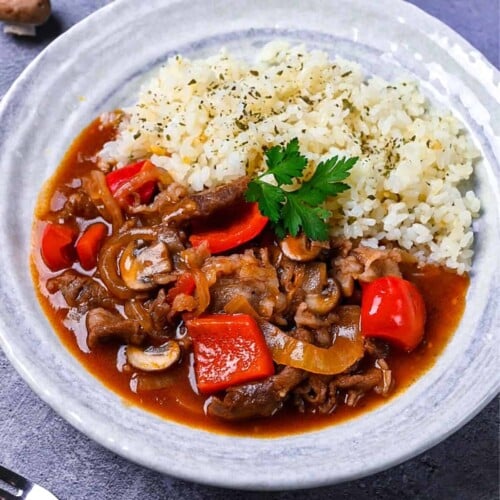
Hayashi Rice (Japanese Hashed Beef with Rice)
Ingredients
“Hayashi” Beef
- 1 bell pepper red or green
- 4 button mushrooms or mushroom of your choice
- ½ yellow onions
- 1 clove garlic
- 200 g thinly sliced beef beef round, boneless beef short-rib, or similar, avoid extremely lean cuts
- 1 pinch salt and pepper
- ½ tbsp all-purpose flour for light coating, or cake flour
- 1 tsp cooking oil neutral
Sauce
- 4 tbsp red wine dry type
- ½ tbsp all-purpose flour to thicken hayashi sauce
- 1½ tbsp tomato ketchup
- 1½ tbsp Worcestershire sauce
- ½ tsp Japanese soy sauce (koikuchi shoyu)
- 300 ml beef bouillon or other bouillon
- 1 bay leaf
- ½ tsp instant coffee powder
- 1 pinch nutmeg powder
- 1 tbsp unsalted butter cold
Rice
- 2 portions cooked Japanese short-grain rice approx. 150 g per person
- 1 tsp butter
- 1 clove garlic minced
- 1 tsp fresh parsley or dry
My recommended brands of ingredients and seasonings can be found in my Japanese pantry guide.
Can’t find certain Japanese ingredients? See my substitution guide here.
Instructions
- Before you start, roughly cube 1 bell pepper, thinly slice 4 button mushrooms and ½ yellow onions, and mince 1 clove garlic .

- Place 200 g thinly sliced beef in a mixing bowl and sprinkle with 1 pinch salt and pepper and ½ tbsp all-purpose flour, toss until evenly coated.

- Preheat a large pan over medium/medium-low heat and add 1 tsp cooking oil. Once heated, add the beef and the sliced mushrooms.

- Sear the beef on both sides and sauté the mushrooms until browned, then transfer to a heatproof container.

- In the same pan, add the sliced onions with a pinch of salt. Cook until golden and soft. If they start to stick, add a splash of water and mix occasionally to unstick them.

- Once softened, add the minced garlic and bell peppers. Fry for about 30 seconds or until fragrant.

- Pour 4 tbsp red wine into the pan and increase the heat to medium/medium-high. Scrape the pan to deglaze and simmer until the alcohol aroma softens and the texture appears syrupy.

- Add the beef and mushrooms back to the pan and sprinkle with ½ tbsp all-purpose flour. Mix until evenly distributed, then add 1½ tbsp tomato ketchup, 1½ tbsp Worcestershire sauce, and ½ tsp Japanese soy sauce (koikuchi shoyu). Stir fry for 1 minute.

- Pour in 300 ml beef bouillon and add 1 bay leaf. Mix well and reduce the heat to a gentle simmer. Stir occasionally and simmer for about 5 minutes or until the sauce thickens and thinly coats the back of a spoon. While you wait, prepare the rice.

- Heat a separate large pan or wok over medium and add 1 tsp butter and 1 clove garlic. Once fragrant, add 2 portions cooked Japanese short-grain rice (cooled) and stir fry for a few minutes to warm the rice through and evenly distribute the ingredients. Sprinkle with 1 tsp fresh parsley and then turn off the heat.

- Once the hayashi is thickened, turn off the heat and add ½ tsp instant coffee powder, 1 pinch nutmeg powder and 1 tbsp unsalted butter. Mix until the butter has melted into the sauce.

- Divide the rice between serving plates, then spoon the hayashi beef generously next to it. Finish with a pinch of parsley and enjoy!

Video

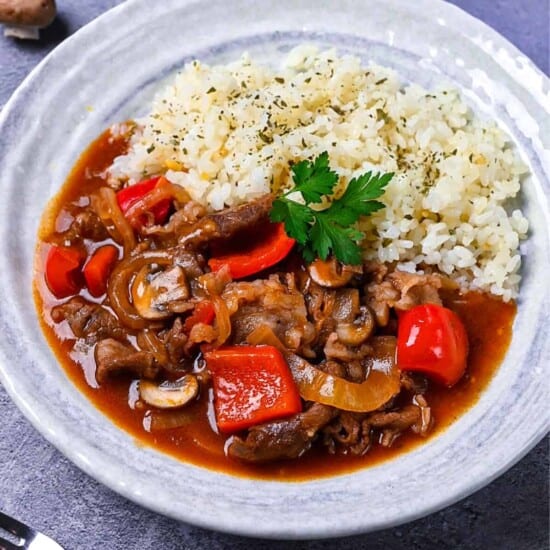



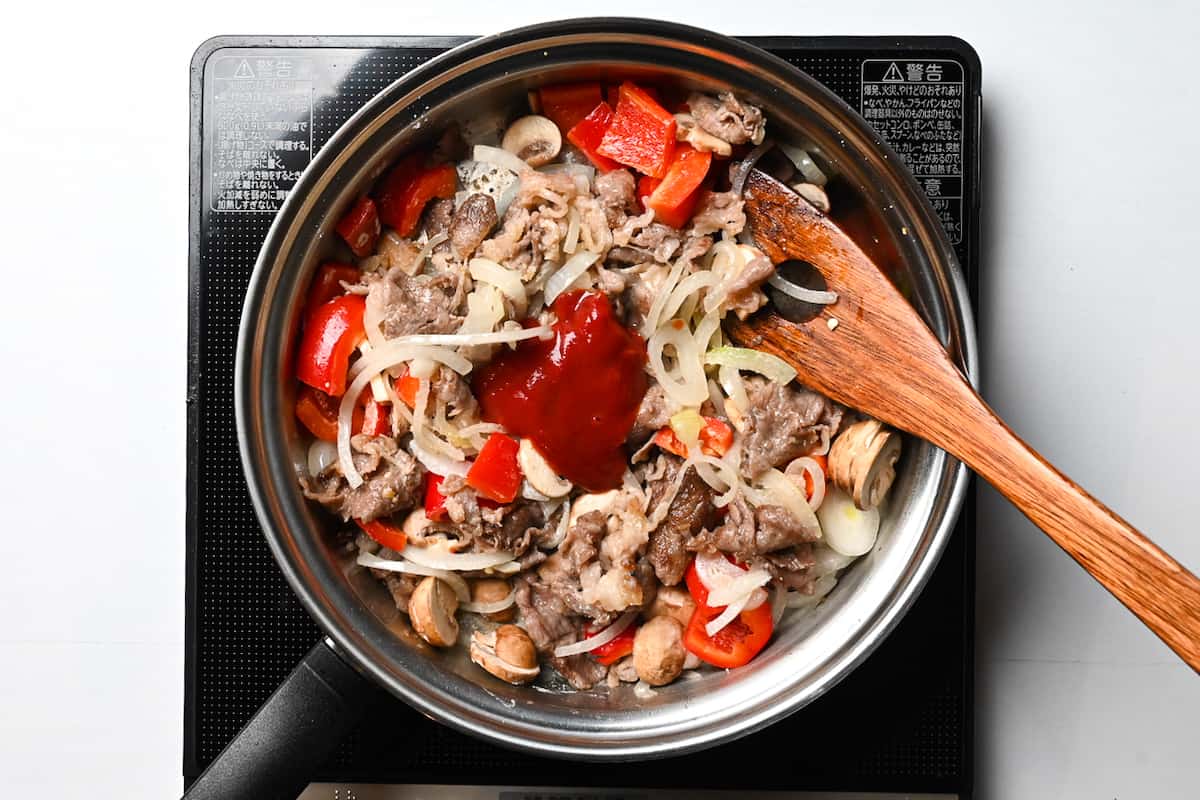
Hi; can I just use the demi glaze instead of making the sauce from scratch?
Hi Dianr T,
Thank you for your question! While I haven’t tested this substitution myself, store-bought demi-glace should work well as a base. I’d recommend adding it gradually and tasting as you go and you may need to adjust the seasoning and consistency to match the original recipe.
Yuto
Can you use tonkatsu sauce instead of Worcestershire sauce?
Hi Astrid,
I haven’t tried that myself, but I think it could work just fine! Let me know how it turns out if you give it a go! 🙂
Yuto